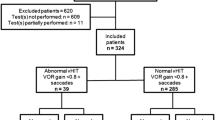Abstract
The video head impulse test (vHIT) has been proposed as an objective approach to detect peripheral vestibular disorder in a clinical setting. Data from several studies indicate that the vHIT is a useful addition to the vestibular test battery and can give complementary information to caloric testing. This study explores the relationship between lateral canal vestibular occular reflex gain measured using the vHIT system and canal paresis indicated using air calorics in a sample of patients attending a clinic for balance disorder. Sensitivity and specificity of the vHIT test relative to calorics was studied for a clinical sample of 51 patients (20 male, 31 female) who attended a private clinic for balance disorders. vHIT gains were compared to the manufacturer’s normative range and to data from a normative study using 30 young volunteers. Of 14 patients in the clinical sample that had significant canal paresis indicated by air calorics, only 4 showed a significant abnormality in either canal using a measurement of vHIT gain. vHIT gain does not correlate with canal paresis as indicated by air caloric testing. vHIT gain appears relatively insensitive to peripheral vestibular disorder as indicated by air caloric testing, although patients that had no caloric response on one side showed abnormal vHIT gain. vHIT testing may be a useful addition to the existing vestibular test battery, but it does not appear to be an alternative to it.




Similar content being viewed by others
Abbreviations
- vHIT:
-
Video head impulse test
References
Perez N, Rama-Lopez J (2003) Head-impulse and caloric tests in patients with dizziness. Otol Neurotol 24(6):913–917
Halmagyi GM, Curthoys IS (1988) A clinical sign of canal paresis. Arch Neurol 45(7):737–739
Jorns-Haderli M, Straumann D, Palla A (2007) Accuracy of the bedside head impulse test in detecting vestibular hypofunction. J Neurol Neurosurg Psychiatry 78:1113–1118
Beynon GJ, Jani P, Baguley DM (1998) A clinical evaluation of head impulse testing. Clin Otolaryngol Allied Sci 23(2):117–122
Schubert MC, Tusa RJ, Grine LE, Herdman SJ (2004) Optimizing the sensitivity of the head thrust test for identifying vestibular hypofunction. Phys Ther 84(2):151–158
Rohrmeier C, Richter O, Schneider M, Wirsching K, Fiedler I, Haubner F, Strutz J, Kühnel TS (2013) Triple test as predictive screen for unilateral weakness on caloric testing in routine practice. Otol Neurotol. 34(2):297–303
Shepard NT (2009) Evaluation of the patient with dizziness and balance disorders. In: Katz J, Medwetsky L, Burkard R, Hood LJ (eds) Handbook of clinical audiology. Lippincott Williams & Wilkins, Philadelphia, pp 467–496
Curthoys IS (2012) The interpretation of clinical tests of peripheral vestibular function. Am Laryngol 122:1342–1352
Ulmer E, Chays A (2005) Curthoys and Halmagyi head impulse test: an analytical device. Ann Otolaryngol Chir Cervicofac 122(2):84–90
MacDougall HG, Weber KP, McGarvie LA, Halmagyi GM, Curthoys IS (2009) The video head impulse test: diagnostic accuracy in peripheral vestibulopathy. Neurology 73:1134–1141
Macdougall HG, McGarvie LA, Halmagyi GM, Curthoys IS, Weber KP (2013) The video head impulse test (vHIT) detects vertical semicircular canal dysfunction. PLoS One 8(4):e61488
Curthoys IS, Bradshaw AP, MacDougall HG, McGarvie LA, Weber KP, Halmagyi GM (2010) Video impulse example data, head impulse testing. http://headimpulse.com/sites/default/files/Understanding_vHIT_data.pdf. Accessed 25 Nov 2012
Tjernstrom F, Nystrom A, Magnusson M (2012) How to uncover the covert saccade during the head impulse test. Otol Neurotol 33:1583–1585
Weber KP, MacDougall HG, Halmagyi GM, Curthoys IS (2009) Impulsive testing of semicircular-canal function using video-oculography. Ann N Y Acad Sci 1164:486–491
Mahringer A, Rambold HA (2013) Caloric test and video-head-impulse: a study of vertigo/dizziness patients in a community hospital. Eur Arch Otorhinolaryngol 271(3):463–472
Zellhuber S, Mahringer A, Rambold HA (2013) Relation of video-head-impulse test and caloric irrigation: a study on the recovery in unilateral vestibular neuritis. Eur Arch Otorhinolaryngol 271(9):2375–2383
MacDougall H, McGarvie L, Halmagyi M, Curthoys I, Weber K (2010) The video head impulse test (vHIT) detects vertical semicircular canal dysfunction. Head impulse testing website. http://www.headimpulse.com/articles/video-head-impulse-test-vhit-detects-vertical-semicircular-canal-dysfunction
GN Otometrics (2011) ICS impulse user manual, Doc no. 7-50-1110-EN/01, Denmark
Blödow A, Pannasch S, Walther LE (2013) Detection of isolated covert saccades with the video head impulse test in peripheral vestibular disorders. Auris Nasus Larynx 40(4):348–351. doi:10.1016/j.anl.2012
Harvey SA, Wood DJ, Feroah TR (1997) Relationship of the head impulse test and head-shake nystagmus in reference to caloric testing. Am J Otol 18(2):207–213
Curthoys IS, MacDougall HG, Manzari L, Burgess AM, Bradshaw AP, McGarvie L, Halmagyi GM, Weber KP (2012) Clinical application of a new objective test of semicircular canal dynamic function— the video head impulse test (vHIT)—a safe, simple and fast clinical vestibular test, head impulse testing. http://headimpulse.com/sites/default/files/2.6.isc.otometrics.pdf. Accessed 25 Nov 2012
British Society of Audiology recommended procedure for the caloric test (2010). http://www.thebsa.org.uk/index.php?option=com_content&view=category&layout=blog&id=7. Accessed 25 Nov 2012
Lightfoot G, Barker F, Belcher K, Kennedy V, Nassar G, Tweedy F (2009) The derivation of optimum criteria for use in the monothermal caloric screening test. Ear Hear 30(1):54–62
Bartolomeo M, Biboulet R, Pierre G, Mondain M, Uziel A, Venail F (2013) Value of the video head impulse test in assessing vestibular deficits following vestibular neuritis. Eur Arch Otorhinolaryngol. Mar 29 [Epub ahead of print]
Maes L, Dhooge I, De Vel E, D’haenens W, Bockstael A, Vinck BM (2007) Water irrigation versus air insufflation: a comparison of two caloric test protocols. Int J Audiol 46(5):263–269
Barros AC, Caovilla HH (2012) From nystagmus to the air and water caloric tests. Braz J Otorhinolaryngol 78(4):120–125
Tole JR (1979) A protocol for the air caloric test and a comparison with a standard water caloric test. Arch Otolaryngol. 105(6):314–319
Capps MJ, Preciado MC, Paparella MM, Hoppe WE (1973) Evaluation of the air caloric test as a routine examination procedure. Laryngoscope 83:10131021
Author information
Authors and Affiliations
Corresponding author
Rights and permissions
About this article
Cite this article
Bell, S.L., Barker, F., Heselton, H. et al. A study of the relationship between the video head impulse test and air calorics. Eur Arch Otorhinolaryngol 272, 1287–1294 (2015). https://doi.org/10.1007/s00405-014-3397-4
Received:
Accepted:
Published:
Issue Date:
DOI: https://doi.org/10.1007/s00405-014-3397-4




